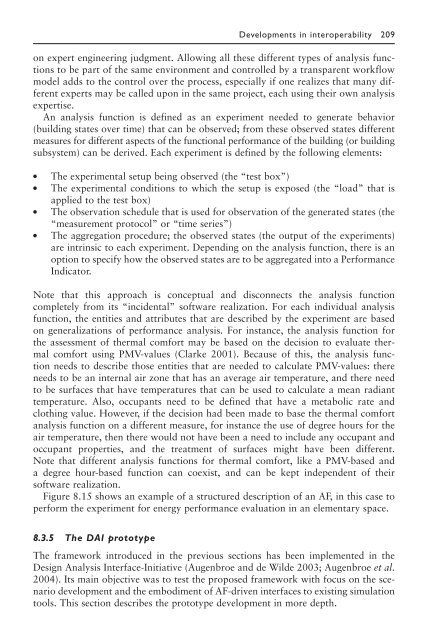Advanced Building Simulation
Advanced Building Simulation
Advanced Building Simulation
Create successful ePaper yourself
Turn your PDF publications into a flip-book with our unique Google optimized e-Paper software.
Developments in interoperability 209<br />
on expert engineering judgment. Allowing all these different types of analysis functions<br />
to be part of the same environment and controlled by a transparent workflow<br />
model adds to the control over the process, especially if one realizes that many different<br />
experts may be called upon in the same project, each using their own analysis<br />
expertise.<br />
An analysis function is defined as an experiment needed to generate behavior<br />
(building states over time) that can be observed; from these observed states different<br />
measures for different aspects of the functional performance of the building (or building<br />
subsystem) can be derived. Each experiment is defined by the following elements:<br />
● The experimental setup being observed (the “test box”)<br />
● The experimental conditions to which the setup is exposed (the “load” that is<br />
applied to the test box)<br />
● The observation schedule that is used for observation of the generated states (the<br />
“measurement protocol” or “time series”)<br />
● The aggregation procedure; the observed states (the output of the experiments)<br />
are intrinsic to each experiment. Depending on the analysis function, there is an<br />
option to specify how the observed states are to be aggregated into a Performance<br />
Indicator.<br />
Note that this approach is conceptual and disconnects the analysis function<br />
completely from its “incidental” software realization. For each individual analysis<br />
function, the entities and attributes that are described by the experiment are based<br />
on generalizations of performance analysis. For instance, the analysis function for<br />
the assessment of thermal comfort may be based on the decision to evaluate thermal<br />
comfort using PMV-values (Clarke 2001). Because of this, the analysis function<br />
needs to describe those entities that are needed to calculate PMV-values: there<br />
needs to be an internal air zone that has an average air temperature, and there need<br />
to be surfaces that have temperatures that can be used to calculate a mean radiant<br />
temperature. Also, occupants need to be defined that have a metabolic rate and<br />
clothing value. However, if the decision had been made to base the thermal comfort<br />
analysis function on a different measure, for instance the use of degree hours for the<br />
air temperature, then there would not have been a need to include any occupant and<br />
occupant properties, and the treatment of surfaces might have been different.<br />
Note that different analysis functions for thermal comfort, like a PMV-based and<br />
a degree hour-based function can coexist, and can be kept independent of their<br />
software realization.<br />
Figure 8.15 shows an example of a structured description of an AF, in this case to<br />
perform the experiment for energy performance evaluation in an elementary space.<br />
8.3.5 The DAI prototype<br />
The framework introduced in the previous sections has been implemented in the<br />
Design Analysis Interface-Initiative (Augenbroe and de Wilde 2003; Augenbroe et al.<br />
2004). Its main objective was to test the proposed framework with focus on the scenario<br />
development and the embodiment of AF-driven interfaces to existing simulation<br />
tools. This section describes the prototype development in more depth.

















